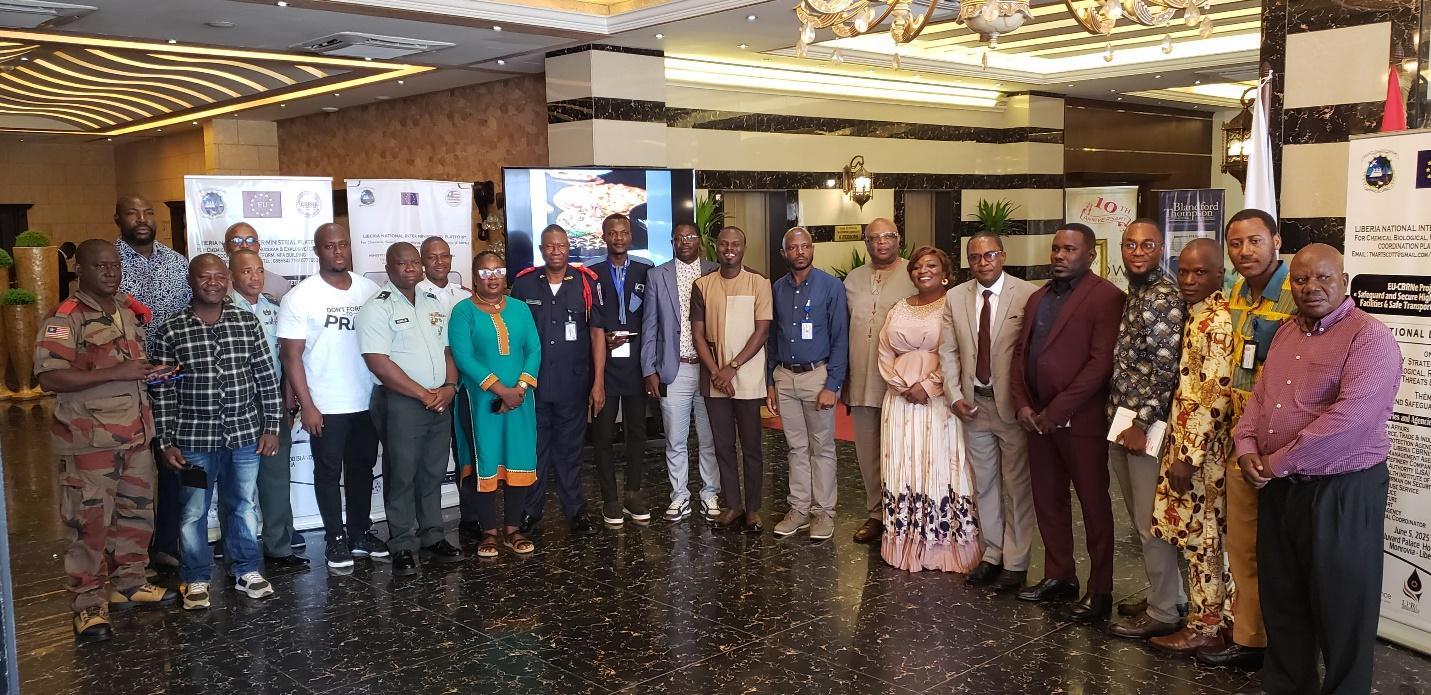Africa-Press – Liberia. Stakeholders from government’s Ministries and Agencies are calling for a stronger action against Chemical Biological, Radio-Nuclear (CBRN) Risk, terming it as a national security threat that needs to be curtailed.
The National Dialogue on Inter-Agency Coordination of Chemical Biological, Radio-Nuclear (CBRNe) Risk, Threats and Disaster Mitigation was held at the Boulevard Palace Hotel in Sinkor. It is supported by the European Union.
Participating Ministries and Agencies are the Ministry of Foreign Affairs, National Fire Service, Liberia National Police, Ministry of Agriculture, Ministry of Transport, National Security Agency, Environmental Protection Agency, the Armed Forces of Liberia CBRNe Unit, National Disaster Management Agency, Liberia Petroleum Refinery Company LPRC, National Standard Authority, National Public Health Institute of Liberia, Ministry of Commerce, Trade and Industry, Liberian Senate Chairman on Security, Defense & Veteran Affairs and the ONE Health National Coordinator.
Asst. Prof. Tabi Martin Scott Tabi is the National Inter-Agency Coordinator on CBRN. Giving the overview of the dialogue, Asst. Prof. Tabi says Chemical, Biological, Radiological and Nuclear (CBRN) materials are essential in various fields of activity including scientific research, healthcare, energy generation, industrial or agro-pastoral activities.
“These materials have the potential to pose health and environmental hazards through accidents and natural disasters. The intentional mis-use of these materials also constitutes a threat to national security and human health,” Asst. Prof. Tabi said.
The purpose of the CBRN National Action Plan (CBRN NAP) according to Mr. Tabi is to provide a policy framework to guide the creation and maintenance of sustainable capabilities and common standards in CBRN policies, programmes, equipment and training.
“The CBRN NAP serves as a national policy-guiding document that is able to consolidate the input from a diverse set of governmental bodies and other stakeholders tasked with responsibilities in CBRN issues,” he said.
Mr. Tabi added: “This strategic document defines, at all levels (national, local and site specific), necessary measures related to material and infrastructure protection and CBRN risk mitigation. It sets the priorities for enhancing capabilities across the main components of crisis management: prevention, detection, preparedness, response and recovery.”
Also supporting the initiative is the European Union (EU) Chemical, Biological, Radiological and Nuclear (CBRN) Risk Mitigation Centres of Excellence (CoE), a global initiative funded and implemented by the European Union as part of its goal to promote peace, stability and conflict prevention.
Reading the statement from the EU, the National Inter-Agency Coordinator on CBRN Mr. Tabi said the EU aimed to mitigate risks and strengthen an all-hazards security governance in partner countries of the EU following a voluntary and demand-driven approach.
According Asst. Prof. Tabi, the EU initiative is led by the European Commission’s Service for Foreign Policy Instruments (FPI), in close coordination with the European External Action Service (EEAS).
The European Commission’s Joint Research Centre (JRC) provides technical support to Partner Countries, while the United Nations Interregional Crime and Justice Research Institute (UNICRI) ensures a coherent and effective national, and international cooperation.
The CBRN CoE Network consists of 63 Partner Countries grouped around eight regions, each facilitated by a Regional Secretariat.
Ten partner countries (Benin, Cameroon, Côte d’Ivoire, Gabon, Liberia, Mauritania, Morocco, Senegal, Liberia, Togo) are within the Regional Secretariat of the Atlantic African Façade.
“The Liberia CBRNe Action Plan is aimed at strengthening CBRN security. While it is first and foremost the responsibility of Liberia to protect its population against CBRN incidents, initiatives at the national level should be guided by the principle of international solidarity,” the statement from the EU quoted.
Also speaking, the Director of the Liberia National Fire Service (LNFS) G. Warsuwah Barvoul Sr. says fighting fire requires the combination of basic training with professional skills, and the use of proper equipment and tools.
According to him, fire disasters involving unidentified Chemical, Biological, Radiological, Nuclear, and explosive (CBRNe) substances present unique and complex challenges for emergency responders.
“Firefighters and emergency personnel may lack adequate CBRNe training,” he said.
The lack of immediate identification of hazardous materials complicates risk assessment, containment, and mitigation efforts, Director Barvoul said.
He added: “Effective response requires not only specialized technical capabilities but also robust inter – ministerial coordination at the national level to ensure a unified, efficient and safe approach.”
According to him, there are key challenges in responding to CBRNe Fire Disasters. Director Barvoul named the identification of Hazardous Substances, unknown CBRNe agents delaying appropriate response strategies are some of the challenges that hinder effective CBRNe response.
For More News And Analysis About Liberia Follow Africa-Press






